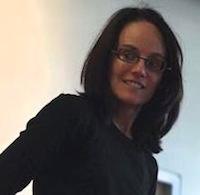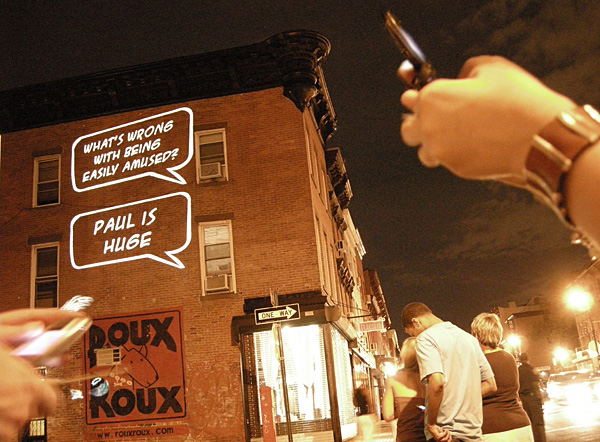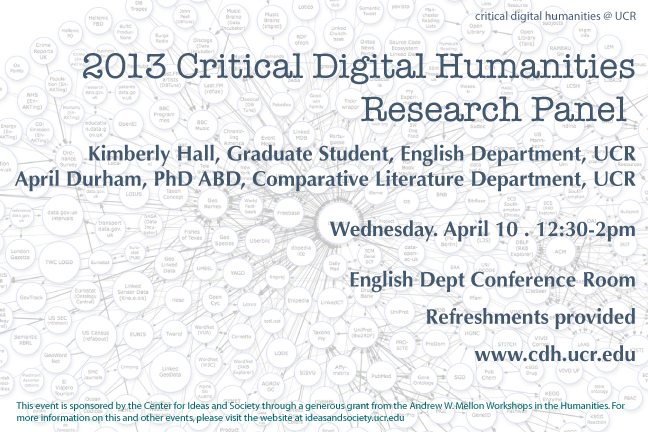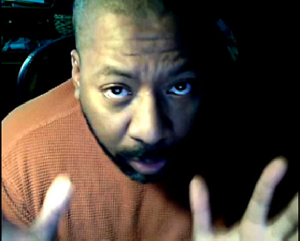Posts from the ‘uncategorized’ Category

The final invited talk of the 2011-2012 Critical Digital season was presented by Dr. Rita Raley from theEnglish department at UC Santa Barbara. Dr. Raley presented a paper that addressed the way that mobile media and projected display are combining to activate public spaces and social exchange.
Considering various art practices that involve viewers as random collaborators, Raley discussed several projects where common media usage, like texting and Tweeting, are made part of a more clearly public dialog. Concerned with the way media devices generate poetic exchange and are then deployed as engagements as in “being in common.” Addressing the specificities of movement and place as material concerns for the poetics of mobile media, Raley points to work that leverages the mobility of the passing viewer and the resistant practices of graffiti art to inhabit a spontaneous and unsanctioned “commons” as a place for conversation. For example in an ongoing project by Paul Notzold, text messages are projected on buildings like apartment blocks, cathedrals, and art museums. Formatted as cartoon thought or speech bubbles, the images seem to indicate that someone inside the building or the building itself is speaking.

While Notzold has installed various iterations of this project at art festivals around Europe, Raley indicated one work in particular where passers by were able to send the messages to a central network that would filter them and then project them shortly after the viewer passed, allowing foot or automobile traffic circulation to determine the audience. “In this context,” Raley argues, “the cell phone becomes a device to explore public space, rather than a device to remove oneself from it, or a means of enveloping oneself in what Michael Bull has called mobile media bubbles.” The activity of migrating the private to the public, or making public space “clickable,” engage questions of relationality and community where “closed-circuit networks of mobile communication technologies” are broken as the audience contributes to the artwork and to a larger public conversation.
Because the work occurs in a long tradition of tagging or territorial marking long used by graffiti artists, especially before this practice became institutionalized, the work reclaims sanctioned common spaces as places to explore “using private modes of communication to drive transient public displays of commentary.” Further, because the functional grammar of SMS employs a kind of truncated spelling, (e.g., “a sudn stream of flrty txt frm 1 I hrdly knw”) emphasize the demands placed on the viewer/ reader to “decode, to “decifr,” to make the seemingly illegible legible,” linking the writing style to the lyrical voice of poetic traditions generally. This means that the material effects of communicative technologies on language are emphasized and raise questions of the potentials for this kind of linguistic construction to bear affectively upon the viewer and upon public communication more generally.
Finally, Raley emphasized the situated or “locative” aspect of this kind of work where textual environments become more about transient display and process rather than the artifact. While documentation can convey the activity of the work, the interactivity and the ephemerality of even this kind of public SMS communication part of the archive of public memory. This talk has been published as part of an anthology, Comparative Textual Media: Transforming the Humanities in the Postprint Era, edited by N. Katherine Hayles (University of Minnesota Press, 2013).
Rita Raley is Associate Professor of English, with courtesy appointments in Film and Media Studies, Comparative Literature, and Global Studies. Her primary research interests lie at the intersection of digital media and humanist inquiry, with a particular emphasis on cultural critique, artistic practices, language, and textuality. She is the author of Tactical Media (Electronic Mediations)(University of Minnesota, 2009), co-editor of the Electronic Literature Collection, Volume 2 (2011), and has more recently published articles on interventionist media arts practices, digital poetics, and global English. She has had fellowship appointments at the National Humanities Center and UCLA, as part of the Mellon-funded project on the Digital Humanities, and has taught at Rice and the University of Minnesota. In Spring 2011 she held a short-term Fulbright appointment with “ELMCIP: Electronic Literature as a Model of Creativity and Innovation in Practice” at the University of Bergen, Norway; and in December 2011 she was a writer in residence hosted by the Dutch Foundation for Literature in Amsterdam. In 2012-2013 she was a visiting Associate Professor in English at NYU.
 The Critical Digital Humanities presents a CDH research panel with presentations by April Durham and Kimberly Hall. They will present drafts of recent research in digital humanities for discussion and comment.
The Critical Digital Humanities presents a CDH research panel with presentations by April Durham and Kimberly Hall. They will present drafts of recent research in digital humanities for discussion and comment.
Wednesday . April 10 . 12:30 – 2
English Department Conference Room
Refreshments will be served.
Yes, it would seem so. Or at least, with the help of a team of brilliant researchers made up of humanities and digital technologies scholars, computers can at least be asked to try and differentiate Gertrude Stein texts from each other, from other highly sophisticated western literary works, and from a cookbook. The punchline? One such computer consistently confused Stein’s Tender Buttons with The New England Cookbook, which was highly popular during Stein’s day. While this may not seem like much of an accomplishment to the average humanities scholar (indeed, as someone on the verge of PhD Qualifying Exams, I’d be quite pleased if this were my qualifying task, instead), it represents a significant accomplishment in the digital humanities, and provides compelling evidence for the ongoing use value of computing in the study of literature.
This brief anecdote was a small portion of a talk given several weeks ago by Dr. Tanya Clement, of UT Austin, to the Critical Digital Humanities Research Group at UCR. Sponsored in part by The Center for Ideas and Society Mellon Workshop, the event was entitled “Sounding it Out: Modeling Aurality for Large-Scale Text Collection Analysis.” Dr. Clement presented research from her collaboration with a computing center at UT Austin, a project that creates computer models for analyzing sound in literary texts. It emerged several years ago out of a drive to expand the affordances of digital archives to include models that could recognize and work through texts based on the way we read them, not just based on the ways we’re currently able to upload and store them (images, text, etc). In this case, the analysis sought to understand how we might argue for the meaning of sound in literary works—not simply sound as part of form or delivery, but sound as meaning.
The project leaders created a set of protocols that would allow them to come up with a usable “knowledge representation” of texts based on sound, even taking into consideration the subjective nature of sound. For example, different readers will read the same text quite differently, based on numerous factors including regional dialect, speed, intonation, enunciation, etc. A central question then became how to make the best guess at how a text actually “sounds,” given these considerations.
Dr. Clement and the research team selected as their primary text, which they then put through a series of digital translations, from text to code to representation to “best guess at sound.” Now, this is obviously a serious reduction and is admittedly a paraphrase, so please forgive my skipping over most of the technical details, as it’s quite elaborate and I probably wouldn’t rehash it very faithfully anyways. I can say this much, however—that the poems were cycled first through a program called OpenMary, then SEASR, and then through ProseVis (someone out there (myself not included) is reading this and knows exactly what this means, and is probably excited about it—I hope so, at least). The end result of this process was a series of data maps that allowed not only some fascinating analysis (which I’ll detail shortly), but which also functioned for Dr. Clement and team as “hypothesis generators,” which allowed them to ask questions such as “Do we care about sound in this poem? Does it matter to meaning?”
So I’ll skip now to flesh out the opening anecdote. The researchers entered 9 texts into the database, including Tender Buttons and two other Stein texts, plus the cookbook, some Joyce, the Iliad and the Odyssey, and more. Just to try to make sure the computer focused on sound, and not just noting the repetition of words, they eliminated words themselves from the analysis, focusing on data about the words and phrases, such as part of speech, accented syllables, phoneme, tone, and more. What they found was pretty remarkable.
Stein scholars have charged that Tender Buttons was written to reflect Stein’s domestic pleasures shared with Alice B. Toklas, her partner of many years. Thus, it’s been argued, Stein modeled the poems on a cookbook. As it turns out, when the computer was asked to recognize which phrases and patterns belonged to which of the 9 texts, it identified them correctly with a fair degree of accuracy. However, the text that it confused most frequently for Tender Buttons was The New England Cookbook. It also regularly confused the Iliad and the Odyssey for each other, which should indicate the relatively sound (ahem) results.
In any case, what all this may mean is that sound does mean. In other words, Stein wrote Tender Buttons not merely to evoke a cookbook through food references and word choice, but she made her poems sound like the recipes. As if we needed another testament to the genius that Stein herself so often and roundly proclaimed.
LACE presents Now he’s out in public and everyone can see, a new 18 channel video installation by artist Natalie Bookchin on view 8 March – 15 April, 2012.
Now he’s out in public and everyone can see weaves together found fragments from online video diaries in which vloggers recount a series of media scandals involving African American men. The multiple stories, originally circulated and enflamed by networks of corporate media gone viral, intersect around themes of racial and class identity and explore popular attitudes, anxieties, and conflicts about race. Bookchin’s work creates a critical context for otherwise isolated and scatter-shot online voices, drawing links, making connections, and locating tropes between individual rants and responses. Where the typical viewer of online video is a single person in front of her screen, the installation produces an active social space where multiple viewers navigate through a media environment, piecing together a fragmented and layered narrative told across space and time.
A major new work by Bookchin, Now he’s out in public and everyone can see was developed over the past two and a half years and is part of a larger body of work in which Bookchin repurposes videos made and circulated online, giving new social shape and form to individual expression. This newest project is spatially and conceptually complex, weaving together many more videos, sounds, voices, narratives, and perspectives into three-dimensional space. This further evolution of form reflects and explores the mix of struggles, conflicts, and harmony in some of the critical stories we as a society are telling today about who we are, and what we aspire to be, and represents a significant step in Bookchin’s practice.
—
Our recent guest, artist Natalie Bookchin, will present a new work called “He’s Out in Public” at LACE in Hollywood. Bookchin uses the massive archive of self-expressive texts on youtube, vimeo, and other social video networking sites to render dynamic orchestrations of sociability and networked expression, exploring the problematics and possibilities of baroque public intimacy. Here are the details about the show and a link to the website with more information about the project:
Opening reception: Thursday, March 8 8-10pm . Show runs March 8 to April 15 .
LACE is located at 6522 Hollywood Blvd. Los Angeles, CA 90028 . phone 323.957.1777
More details about “He’s Out in Public”
Last week Apple announced a free download of its “book authoring” software for iBooks, “iBook Author” – the PR is at
http://www.apple.com/ibooks-author/
iBook Author appears to be an updated, more graphical and better integrated version of the free app authoring software tools for developers Apple has offered for a couple of years now, but that haven’t yet been well suited for more general users. It requires OSX 10.6.8, to which many Mac computers older than 5 or 6 years can’t be upgraded (if you have a Core Duo instead of a Core 2 Duo, for instance, you’re out of luck). Reviews are early and tentative and not worth linking to here as yet. But according to one report, the iBook Author format is proprietary instead of aimed at supporting open authoring of “digital book” formats, so the usual complaints are already flowing.
http://www.zdnet.com/blog/bott/how-apple-is-sabotaging-an-open-standard-for-digital-books/4378
Generally, if you want to take full advantage of proprietary features of a specific hardware/software platform, you’re likely to have a problem meeting “open” compatibility standards to some meaningful degree. So that complaint is hardly surprising.
But the pitch Apple is making is not to pre-empt open standards for “digital books” (yuck!) per se, and rather to prime educational multimedia publishing with better support for (of course) iPad-oriented educational multimedia (shades of Hypercard!), for educational markets. I’ll be upgrading to a new laptop soon (yes, my MacBook is that old!) and will be checking the software out soon. I’ll keep you posted.
I saw this story today about how Amazon has started a “Lending Library” for Kindle Users. As the article explains, this service is only open to kindle users with a Prime Membership, complicating notions of socio-economic classes associated with the use of lending libraries, and maybe this is something studies of digital (as compared with physical) libraries could look into. In the meantime, though, I think this development could be of interest to anyone working in library studies, since it expands the digital library-as-archive into the library-as-lending/borrowing-space.
Dr. Rita Raley, Associate Professor in the English Department of UCSB, and author of Tactical Media (Minnesota, 2009), has confirmed for an April 19 2012 talk.
We’ll post the room and time information as the event approaches.
We had to cancel the November 1 presentation by Alex Juhasz and Natalie Bookchin, but we’ve been able to re-schedule them for January 31 at 4 PM.
The event will be in HMNSS 1500 from 4:00-5:30pm, and refreshments will be served.
We’ll update site information as the event approaches.
This Sunday morning panel has two of our members and four relevant presentations ….
http://www.pamla.org/2011/sessions/comparative-media
Join us on Tuesday, 10/11, at 6 pm in HMNSS 2212 (English Dept. Conference Room) to discuss the circulated readings on theories of affect. April Durham will discuss the intellectual genealogy of affect from Spinoza through Deleuze and Guattari (Thanks April!!). We’ll then open it up for seminar style discussion of the readings. Contact Richard Hunt or April Durham with any questions.
For more information, visit the Reading Groups Projects Page.




